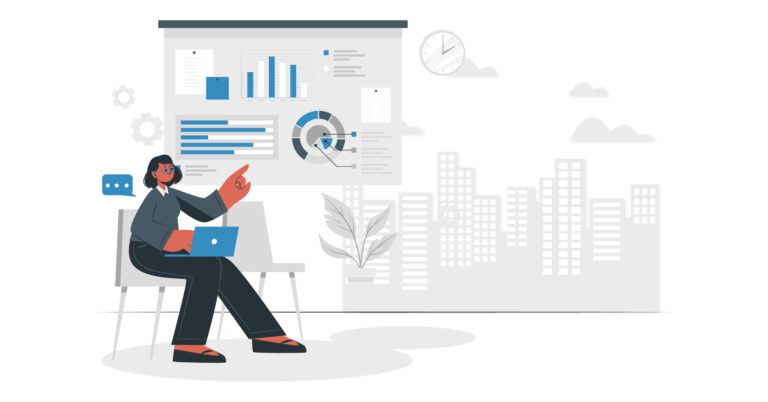Have you ever wondered how some real estate data analytics companies reach success faster? Is it improved manpower, technology, or a combination of both at play?
Well, it’s real estate data visualization that helps those companies outpace competition.
Data visualization lets you transform raw data into attractive visuals. It is known for presenting complex information in a simple and insightful manner. Businesses and real estate agents can harness their power to make informed decisions and customize strategies for customers.
Let’s see how real estate data visualization and analytics can help you go win-win in the real estate business.
Table of Contents
What is Real Estate Data Visualization?

Real estate data visualization is not merely creating beautiful visuals. Rather it can be used to:
- Track the number of available properties
- Get apt price breakdowns
- Calculate the average number of properties in the market before being sold
You can choose to leverage static data visualization or make it seamless via interactive data visualization. The latter helps you zoom in and click on different parts of a larger data set.
The Role of Real Estate Data Analytics in Decision-Making

Real estate data analytics can help you predict future trends, assess risk, and leverage multiple investment opportunities. This will not only reduce costly mistakes but also boost overall operational efficiency.
1. Analyze Key Sources and Metrics
Real estate data analytics lets you gauge the impact of key sources and metrics of the data. The data includes property transaction records and demographic data. Real estate data visualization leverages advanced metrics like AI and predictive analytics to get the best results.
2. Access Demographic Data
Demographic information is the backbone of all real estate data. Information related to age, income, and employment status can be leveraged using real estate data analytics to identify potential markets and make better decisions.
3. Streamline Property Transaction Records
Analyzing property transaction records manually can be tedious. However, not doing so is a recipe for disaster. With data visualization, you can easily derive insights into buying and selling trends within a defined market. This will also help you gain a better understanding of the market’s direction and fine-tune your decision-making.
4. Leverage Advanced Analytics Metrics
If you are keen on going the extra mile, you need to leverage predictive analytics and AI like there is no tomorrow. Imagine if you can model potential scenarios and take action before your competitors. The key is to effectively harness the power of data and boost efficiency.
5. Optimize Pricing Strategies
Real estate data visualization will help you analyze pricing trends and monitor competitor pricing with enhanced ease. You can then strategically price properties to boost profitability and attract potential buyers. Furthermore, the insights you will gather will ensure that market dynamics are taken into account.
6. Reduce Developmental Costs
Development expenditures can easily be controlled by analyzing past statistics. This will determine the quantity of unprocessed materials and thus reduce wastage by significant margins. Furthermore, real estate firms can estimate the asset’s price and sell below that prediction, ensuring higher profits on each transaction.
Data Semantics: Simplifying Real Estate Data Visualization for Enterprises

Real estate data visualization will not only help you make better decisions, and transform sales strategies but it will also help you personalize your offerings and optimize pricing strategies. With Data Semantics by your side, you need not sit down to decode complex data. Here is how you can empower your team to make better decisions:
- Enhanced Visualization Capabilities and seamless data organization
- Simplified Discovery of Trends & Patterns
- ChatGPT- Enabled Dynamic BI Reporting
With advanced analytics, you can identify market trends and tailor strategies to meet the demands of customers. Moreover, you will be able to utilize marketing resources to the maximum and get higher ROIs continuously.
FAQs
1. How does real estate data visualization aid marketing?
Data visualization is the key to making raw data crystal clear and easy to understand. Tracking trends and patterns over time and comparing performances to have a solid overview of your marketing and sales metrics becomes easier.
2. How is data analytics useful for real estate businesses?
Data analytics can help real estate businesses with investment strategies, track property performance, and keep a tab on key economic indicators. Investors can also identify high-potential investment opportunities and avoid risks.
3. What are real estate databases?
Real estate databases are cloud or on-premise solutions that maintain a centralized repository of data related to properties. It is used with a web application that simplifies interaction with aggregated property data.
4. How does the market data approach help in real estate?
The market data approach involves finding values by comparing properties of similar size.
5. Why is property analysis done?
A property analysis gives investors an accurate analysis of expected ROI on rental yields, cash flow, capital appreciation, and debt service coverage ratios.











